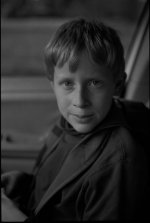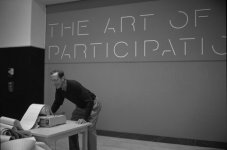David William White
Well-known
My two cents:
There is nothing I have ever seen in the world of imaging that equals the color saturation, sharpness, depth, detail, reality and jaw-dropping impact of a perfect slide, perfectly projected.
In July 1969 I studied at the Leica School in Wetzlar and they projected 35mm Koadachromes and Agfachromes in the Leica Theatre onto a 20 foot wide screen using the giant Leitz Prado 500 projector with the big Hektor lens.
Now, it's almost 40 years later and I still get goosebumps remembering those images.
Yes, yes, yes! We must attempt to keep slide projections alive somehow. It's such a waste to shove slide film into a crappy scanner and then show people our crappy scans on crappy web pages on crappy monitors.
dfoo
Well-known
Yeah, but its kinda hard to project that slide across the country 
sooner
Well-known
I'm the first to admit I'm more of a gear head than a good photographer, and have no helpful workflow solutions. Here are three of the better shots from recent batch of Scala slides. First of all, the slides are all way better than the scan son my Scan Elite II. On most slides, I have to increase the contrast a bit, and maybe lighten the overall scene.
Attachments
humanized_form
Established
One reason to shoot chromes, that hasn't been mentioned, is the workflow. Once you press the shutter, you're basically done. All you need to do is to have the film developed and mounted and then project them or look at them through a viewer. You can even have them scanned for you. There's no need for a darkroom, wet or dry.
While you can have someone else develop and print negatives or print your digital photos, you do lose control. With negative film or digital capture, you need to process yourself to maintain control of the outcome. With slides, all decisions about how the finished product will come out can be made in the camera and it doesn't matter if you have the processing done (as long as you have a competent developer) or do it yourself .
I'm one who thinks that we are all very fortunate to live in a time where there are so many options. I enjoy using my digital equipment as well as my film equipment. Workflow is one area where I really appreciate slide film. I'm not a very technical guy and spending hours in front of a computer is not what I consider fun. I was reading an article on Tom Hogan's website where he was suggesting buying several RAW converters, so you can run your images through each to see which one you like the best. One would really need to like working on a computer a lot to go that route.
The cost is a relative thing. A roll of Provia 100 and a Fuji slide mailer costs $11.24 plus shipping from Adorama as of today. Add 82 cents postage to send in the mailer and you're up to around $12.25 per roll if you buy several rolls and mailers at the same time. If you averaged a roll of film per week, your cost per year would be $637. Other forms of photography have costs as well and I wouldn't say that slide photography is the cheapest, but it wouldn't be difficult to spend a similar amount regardless of the type of photography you use.
yes. the picture is the picture. i think of looking at slides as like looking at little jewels. they are pretty to look at as they are.
slide film is like the ultimate jpeg (without artifacts) or like a raw file that gets cooked in the camera.
and film has many flavors. slide film doesn't have to be spazzy, tight, highly saturated, high contrast, and difficult to scan. something like e100g is beautiful to play with. kodachrome has a different flavor that is fun, like being friends with a dinosaur or something, haha.... hanging out with something that is the last of its kind, and so you appreciate it greatly while it is still around.
have fun.
ks
mooge
Well-known
ah...
my first foray with slides was with Kodachrome 64 found in my freezer with the mailer. one of them free film (!) moments. and old it was- it expired BEFORE I WAS BORN- in 1989...
shot and sent back- I'm quite impressed, but the real thing I like about slides is that they can be projected... and we've got a Leica projector. A Leica projector! it's minty too- still smells awful (new). and I like to share (show off?) my pictures...
my first foray with slides was with Kodachrome 64 found in my freezer with the mailer. one of them free film (!) moments. and old it was- it expired BEFORE I WAS BORN- in 1989...
shot and sent back- I'm quite impressed, but the real thing I like about slides is that they can be projected... and we've got a Leica projector. A Leica projector! it's minty too- still smells awful (new). and I like to share (show off?) my pictures...
Leighgion
Bovine Overseer
But 30+ megapixels from Hasselblad, Leica, Leaf, etc., are pretty amazing. r
If only the prices weren't so amazing, I might own something in that line.
Rayt
Nonplayer Character
I print b/w on an Epson inkjet and am satisfied with the results. Since I have given up on the prospects of ever doing any traditional printing again I have decided to stop shooting b/w film and opt for color and then digitally convert to b/w. I use Silver Efex and prefer the conversion from scanned slide film over negatives. The results look better to me. I will likely stay with Fuji 400X for that slightly grainy look.
chachi
Member
because my dad shot kodachrome and his dad shot kodachrome. and those slides look incredible.
shadowfox
Darkroom printing lives
Because some slides look like this after 50 years plus...
http://freeforumzone.leonardo.it/discussione.aspx?idd=7155592
http://freeforumzone.leonardo.it/discussione.aspx?idd=7155592
Svitantti
Well-known
Ok, just highjacking the thread, am I?
My question: Same position, same scene, same light; but put on slide and put on neg film: which print will look better? Any method: optical print, scanned print, whatever.
I am interested in the print in hand, on the wall here.
Which medium wins? Slide or neg film? Say Kodachrome versus Kodak 400 UC or such.
Which one wins: pizza or spaghetti?
It is relative and a matter of personal preference of certain subjective properties of the results.
...Ok, Ilfochrome is awesome as prints, but very expensive. If you want ultimate film color prints, Ilfochrome is one of the best choices.
I guess some inkjet prints on quality paper with quality inks can get somewhat close, but I have never seen them.
Even with Ilfochrome vs. RA-4 it is a matter of personal taste and depens on the project or case you are working on, which one is better.
Is there an absolute "better" or best in "art"?
Muggins
Junk magnet
Originally posted by ShadowFox:
Oh my... Thank goodness I wasn't drinking coffee, I'd have dropped the cup!
Adrian
Because some slides look like this after 50 years plus...
http://freeforumzone.leonardo.it/dis...px?idd=7155592
Oh my... Thank goodness I wasn't drinking coffee, I'd have dropped the cup!
Adrian
Last edited:
Svitantti
Well-known
Too bad those are 4x5 Kodachromes, which really aren't available anymore (or processed).
Heres the original source (and for some more) I guess: http://www.shorpy.com/
Heres the original source (and for some more) I guess: http://www.shorpy.com/
funkaoshi
Well-known
I think those images are from the Library of Congress. They've been online for a while thanks to a project from Flickr.
B
bedaberger
Guest
I don't know why, but it seems that all over the world slide fim and E6 developing is very expensive! Except Germany and also Austria:
I can get 5 Fuji Sensia 100 incl. vouchers for developing for less than € 25!
Where else in the world can you find cheap slides?
How is the sit. in Japan?
I also like the colors of scanned negative, but they always get so grainy...
i tried Fuji Superia X-tra 400 on the Coolscan V, did i make something wrong?
Peter
I can get 5 Fuji Sensia 100 incl. vouchers for developing for less than € 25!
Where else in the world can you find cheap slides?
How is the sit. in Japan?
I also like the colors of scanned negative, but they always get so grainy...
i tried Fuji Superia X-tra 400 on the Coolscan V, did i make something wrong?
Peter
dfoo
Well-known
Grain is relative to the DPI of the scan... if you are looking at grain at a 4000 DPI scan when zoomed to 100%, then that isn't a very meaningful unless you plan on printing 18"x12".
I don't know why, but it seems that all over the world slide fim and E6 developing is very expensive! Except Germany and also Austria:
I can get 5 Fuji Sensia 100 incl. vouchers for developing for less than € 25!
Where else in the world can you find cheap slides?
How is the sit. in Japan?
At the place I use in Yokohama, I pay the equivalent of about € 30 to get 5 rolls of 36 shot film (more like 38 shots usually) developed and placed in sleeves (not mounted). It's not as cheap as some places but they can do it in about an hour if needed.
Michael P.
Bronica RF
Chris, what film is that scan from?
Chriscrawfordphoto
Real Men Shoot Film.
Chris, what film is that scan from?
I had two photos in the thread. The cat photo is very old, maybe 12 years ago. He was my son's mother's cat, and I took that photo before our son was born (he will be 12 later this month). I think I used the original Provia 100 (RDP II), but I may be wrong, i'd have to dig the slide out from the archives to check.
The photo of the kitchen was done on Fuji NPS 160, a color print film.
Share:
-
This site uses cookies to help personalise content, tailor your experience and to keep you logged in if you register.
By continuing to use this site, you are consenting to our use of cookies.




